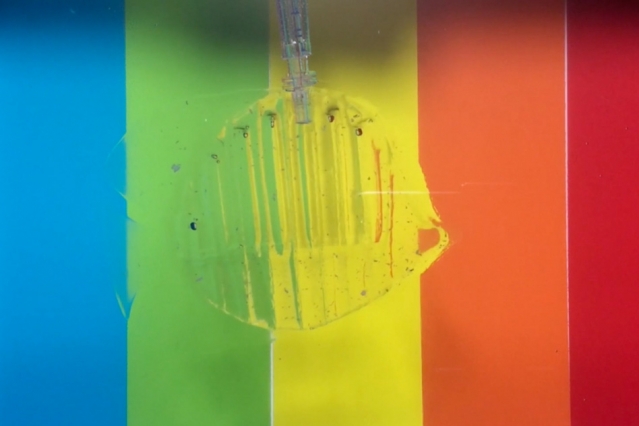
A new robot comprised of hydrogel has the ability to grab fish and kick a ball underwater. Credit: The Massachusetts Institute of Technology
A newly created robot may soon be hitting your local lake and catching a haul of trout, bass or pike.
Engineers at the Massachusetts Institute of Technology (MIT) have developed a robot entirely made of hydrogel that is able to perform a number of tasks, including kicking a ball underwater and grabbing and releasing a live fish.
Hydrogel is a tough, rubbery, nearly transparent material that is composed mostly of water.
Each robot is a hollow, precisely designed hydrogel structures connected to rubbery tubes. When the researchers pump water into the robots, the structures quickly inflate in orientations that enable the bots to curl up or stretch out.
The research team—led by Xuanhe Zhao, an associate professor of mechanical engineering and civil and environmental engineering at MIT and graduate student Hyunwoo Yuk—designed several hydrogel robots, including a finlike structure that flabs back and forth, an articulated appendage that makes kicking motions, and a soft, hand-shaped robot that can squeeze and relax.
The robots are both powered by and made almost entirely of water, which means they have similar visual and acoustic properties to water. In underwater applications, they may end up being virtually invisible, stated researchers.
The research team developed the hydrogels by mixing solutions of polymers and water and using techniques they invented to fabricate tough yet highly stretchable materials.
They developed a way to glue the hydrogels to various surfaces, including glass, metal, ceramic and rubber, creating extremely strong bonds that resist peeling, making the durable, flexible and strongly bondable material ideal for use in soft robotics.
In the past, engineers have designed soft robots from rubber like silicones, but according to Zhao, those materials are not as biocompatible as hydrogels.
The researchers first looked to the animal world to apply their materials, concentrating on leptocephali or glass eels—tiny, transparent, hydrogel-like eel larvae that hatch in the ocean and eventually migrate to their natural river habitats.
“It is extremely long travel and there is no means of protection,” Yuk said. “It seems they tried to evolve into a transparent form as an efficient camouflage tactic. And we wanted to achieve a similar level of transparency, force, and speed.”
The researchers used 3D printing and laser cutting techniques to print the hydrogel recipes into the robotic structures and other hollow units, which they bonded to small, rubbery tubes that are connected to external pumps.
To move the structures, the team used syringe pumps to inject water through the hollow structures, enabling them to quickly curl or stretch, depending on the configuration of the robot.
During the experiments the team found the structures were able to withstand repeated use of up to 1,000 cycles without rupturing or tearing.
The team also found that each design, placed underwater against colored backgrounds appeared almost entirely camouflaged.
The robots have a fabricated hand-like robotic gripper and pumped water in and out of its fingers to make the hand open and close.
“[The robot] is almost transparent, very hard to see,” Zhao said. “When you release the fish, it’s quite happy because [the robot] is soft and doesn’t damage the fish. “Imagine a hard robotic hand would probably squash the fish.”
The next step will be to identify the specific applications for hydrogel robotics, as well as tailor the recipes for particular uses, including for medical applications, said Zhao.
“Hydrogels are soft, wet, biocompatible and can form more friendly interfaces with human organs,” Zhao said. “We are actively collaborating with medical groups to translate this system into soft manipulators such as hydrogel ‘hands,’ which could potentially apply more gentle manipulations to tissues and organs in surgical operations.”
Hydrogels are also naturally safer to use in biomedicals because they are mostly comprised of water.
There are numerous other possible applications for this technology, said Yuk.
“We want to pinpoint a realistic application and optimize the material to achieve something impactful,” said Yuk in a statement. “To our best knowledge, this is the first demonstration of hydrogel pressure-based acutuation.
“We are now tossing this concept out as an open question, to say, ‘Let’s play with this’.”
The study was published in Nature Communications.




